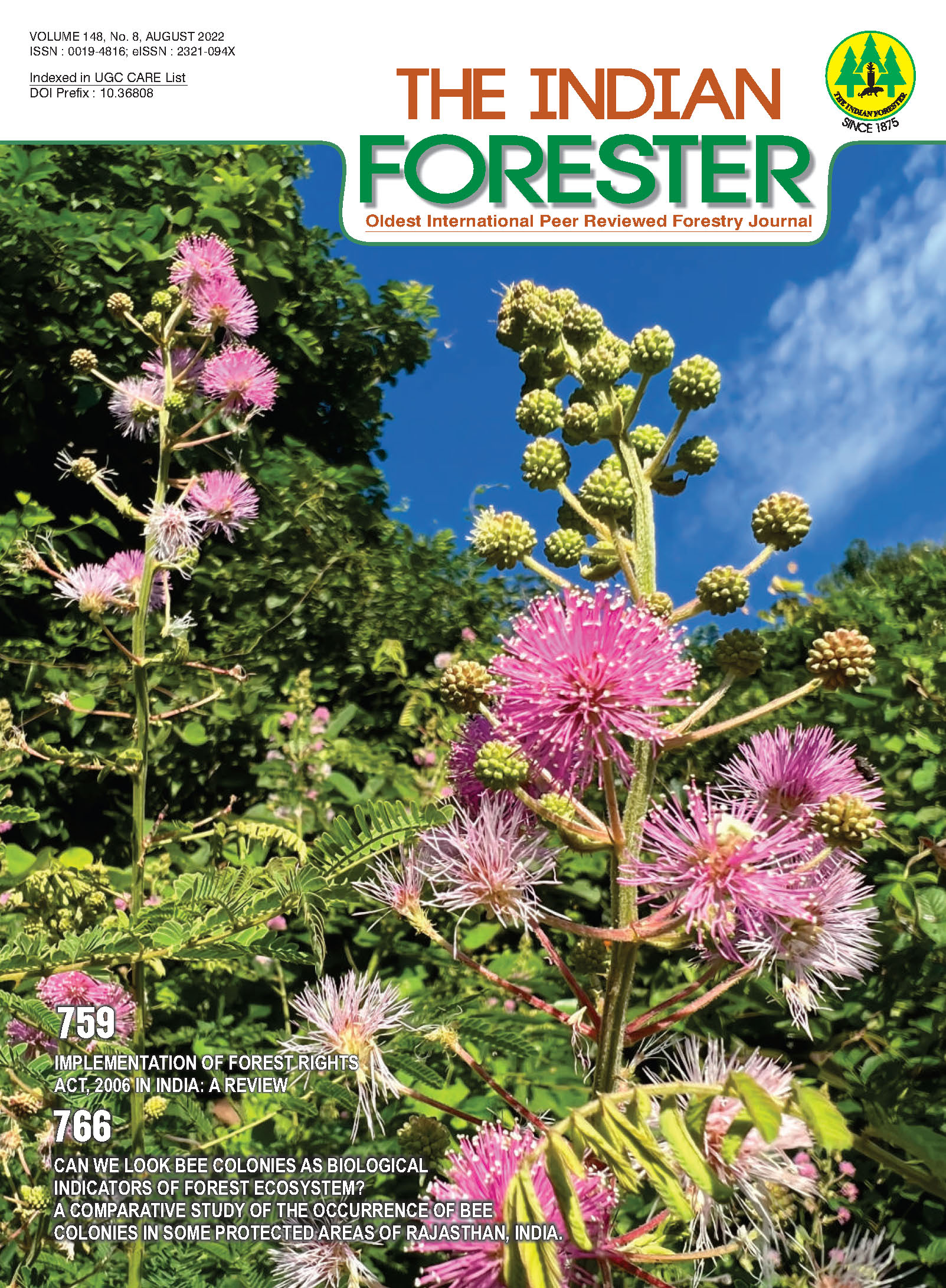Growth Assessment of Young Plantation of Santalum album with Dalbergia latifolia as Host
DOI:
https://doi.org/10.36808/if/2022/v148i8/162882Keywords:
Indian Sandalwood, Indian Rosewood, growth, Plantation, heartwoodAbstract
Indian Sandalwood (Santalum album) is a highly valued partial root parasite tree and the prized heartwood is considered as 'wood of choice' in carving and oil obtained from steam distillation of heartwood is regarded as 'aroma of choice' in perfume industry. Due to large scale reduction in natural population, it is categorised as 'threatened' by International Union for Conservation of Nature. Earlier it was recognised as Royal tree in Karnataka and Tamil Nadu, because of which even basic information about growth was lacking. With the relaxed government policies and the increased demand for heartwood and oil, farmers and entrepreneurs are motivated to cultivate Sandalwood. Presently, numerous plantations are being raised and documenting growth data from these plantations is very important. During a survey of Sandalwood plantations in Karnataka, an eight year old unique Sandalwood plantation was identified which had Indian Rosewood (Dalbergia latifolia) as host and growth data was collected. The Sandalwood trees girth at breast height (GBH) varied from 13.9 to 31.2 cm with an average GBH of 19.24 cm and average tree height was 6.02 m varying from 5.0 to 9.5 m. Rosewood had mean tree height and GBH of 8.72 m and 29.18 cm, respectively. Core samples collected from Sandalwood trees above 30 cm girth did not show any indications of heartwood formation. This study would augment necessary information required for developing package and practices on Sandalwood cultivation.References
Anon. (1983). Troup's The Silvicuture of Indian Trees. Vol IV, Controller of Publications, Delhi.
Arunkumar A.N., Dhyani A. and Joshi G. (2019). Santalum album. The IUCN Red List of Threatened Species 2019: T31852A2807668.http://dx.doi.org/10.2305/IUCN.UK.20191.RLTS.T31852A2807668.en. Downloaded on 30 May 2020.
Barbour L. (1998). Analysis of Plant-Host Relationships in Tropical Sandalwood (Santalum album). RIRDC Publication No 08/138, Barton, Government of Australia.
Barbour L., Plummer J. and Norris L. (2012). Flood-irrigated tropical timber trials in the North of Western Australia. RIRDC Publication No12/044, Government of Australia.
Brand J., Kimber P. and Streatfield J. (2006). Preliminary analysis of Indian sandalwood (Santalum album L.) oil from a 14-year-old plantation at Kununurra, Western Australia, Sandalwood Research Newsletter, 21: 1–3.
Brand J.E., Norris L.J. and Dumbrell I.C. (2012). Estimated heartwood weights and oil concentrations within 16-year-old Indian sandalwood (Santalum album) trees planted near Kununurra, Western Australia, Australian Forestry, 75: 225232.
Dhanya B., Viswanath S. and Purushothman S (2010). Sandal (Santalum album L.) conservation in southern India: A review of policies and their impacts, Journal of Tropical Agriculture, 48: 1-10.
Kruger R., Zauer M. and Wagerfuhr A. (2018). Physical properties of native and thermally treated European woods as potential alternative to Indian rosewood for the use in classical guitars.HolzalsRoh- und Werkstoff, 76: 1663-1668.
Kumar A.N.A., Joshi G. and Ram H.Y.M. (2012). Sandalwood: history, uses, present status and the future, Current Science, 103: 325-329.
Lakhey P., Pathak J. and Adhikari B. (2020). Dalbergia latifolia. The IUCN Red List of Threatened Species 2020: e.T32098A67777757. https://dx.doi.org/10.2305/IUCN.UK.20203.RLTS.T32098A67777757.en. Downloaded on 30 May 2021.
McComb J. (2009). Clonal Santalum album growth, oil content and composition on different hosts and at different locations, Journal of the Royal Society of Western Australia, 92: 15-25.
Mishra B., Chakraborty S. and Sandhya M.C. and Viswanath S. (2018). Sandalwood farming in India: Problems and prospects. Indian Journal of Tropical Biodiversity, 26: 1-12.
Nagaveni H.C. and Vijayalakshmi G. (2003). Growth performance of sandal (Santalum album L.) with different host species. Sandalwood Research Newsletter, 18: 1-4.
Nath C., Pe´lissier R., Ramesh B.R. and Garcia C. (2011). Promoting native trees in shade coffee plantations of southern India: comparison of growth rates with the exotic Grevillea robusta, Agroforestry Systems, 83: 107-119.
Radomiljac A.M. and McComb J.A. (1998). Nitrogen-fixing and non-nitrogen fixing woody host influences on the growth of the root hemi-parasite In: Sandal and its Products, ACIAR Proceedings No.84, Proceedings of an International Seminar, 18-19 December, Bangalore, India, ACIAR, Canberra pp. 54-57.
Rai S.N. (1990). Status and cultivation of sandalwood in India. In: Proceedings of the Symposium on Sandalwood in the Pacific, 9–11 April 1990, Honolulu, Hawaii, US Forest Service General Technical Paper PSW–122, pp 66–71.
Sellin A. (1991). Variation in sapwood thickness of Piceaabies in Estonia depending on the tree age, Scandinavian Journal of Forest Research, 6: 463-469.
Shetty R.H. (1977). Spread and yield of Sandal in Javadis. Proceedings of All India Sandal Seminar, Karnataka Forest Department, Bangalore, pp 68-72.
Singh B., Singh G., Rathore T.S. (2018). The effects of woody Hosts on Santalum Album L. tree growth under Agroforestry in semi-arid North Gujarat, India, Indian Forester, 144: 424430.
Srimathi R.A., Kulkarni H.D. (1980). Preliminary findings of the heartwood formation in sandal (Santalum album L.). In: Proceedings of Second Forestry Conference, FRI and Colleges, Dehra Dun, 1980, pp 1–13.
Swaminath M.H., Hosmath B.J. and Mallesha B.B. (1998). The status of Sandalwood in India: Karnataka. In: Sandal and its Products, ACIAR Proceedings No.84, Proceedings of an International Seminar, 18 - 19 December, Bangalore, India, ACIAR, Canberra, pp. 3–5.
Thapa H.B. (2004). Early growth, thinning yield and estimated biomass of standing trees of Dalbergia latifolia Roxb. in the eastern Terai, Nepal, Banko Janakari, 14: 31-40.
Venkatesan K.R. (1980). A fresh look at the management of Sandal. In: Proceedings of Second Forestry Conference, FRI and Colleges, Dehra Dun, pp 24-28.
Downloads
Downloads
Additional Files
Published
How to Cite
Issue
Section
License
Unless otherwise stated, copyright or similar rights in all materials presented on the site, including graphical images, are owned by Indian Forester.





